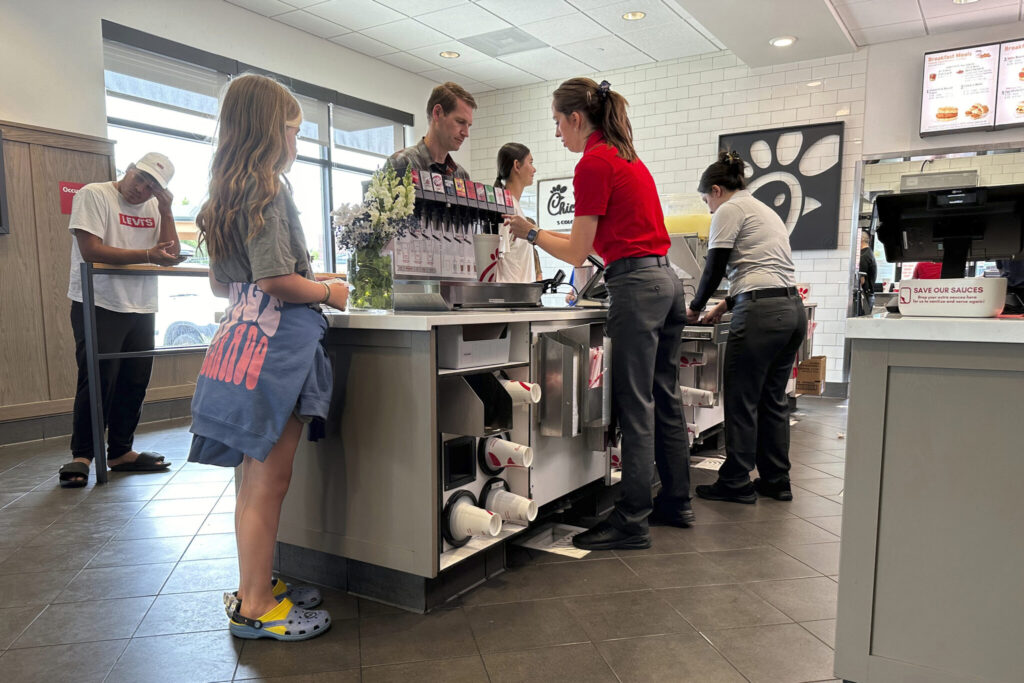Inflation in the United States cooled in June for a third straight month, a sign that the worst price spike in four decades is steadily fading and may soon usher in interest rate cuts by the Federal Reserve. Consumer prices declined 0.1% from May to June after having remained flat the previous month, the government reported Thursday. Measured from 12 months earlier, prices were up 3% in June, down from 3.3% in May.
Quick Read
- Inflation in the United States cooled in June for a third straight month, indicating the worst price spike in four decades is steadily fading and may soon lead to interest rate cuts by the Federal Reserve.
- Consumer prices declined 0.1% from May to June after remaining flat the previous month, as reported by the government on Thursday.
- Measured from 12 months earlier, prices were up 3% in June, down from 3.3% in May.
- The latest inflation readings could convince the Fed’s policymakers that inflation is returning to its 2% target.
- A brief pickup in inflation early this year caused Fed officials to scale back expectations for interest rate cuts, saying they needed to see several months of mild price increases to feel confident enough to cut their key rate from its 23-year high.
- If inflation remains low through the summer, many economists expect the Fed to begin cutting its benchmark rate in September.
- Despite slowing inflation, costs of food, rent, health care, and other necessities remain much higher than before the pandemic, causing public discontent and potentially threatening President Joe Biden’s re-election bid.
- Excluding volatile food and energy costs, core prices climbed just 0.1% from May to June, below the 0.2% increase the previous month.
- Measured from a year ago, core prices rose 3.3% in June, down from 3.4% in May. Core prices are thought to provide a particularly telling signal of where inflation is likely headed.
- Fed Chair Jerome Powell stated on Wednesday that there had been “considerable progress” in slowing inflation to the Fed’s 2% target but cautioned that policymakers want to see further similar data.
- Economists, investors, and Federal Reserve officials are optimistic that U.S. inflation is nearly under control, with the latest report on consumer prices expected to show another month of mild increases.
- The report, to be released Thursday, is expected to show a 0.1% increase in consumer prices from May to June, following an unchanged reading the previous month.
- Year-over-year inflation for June is predicted to be 3.1%, down from 3.3% in May, influenced by lower gas prices and slight increases in grocery costs.
- Federal Reserve Chair Jerome Powell emphasized the need for more consistent positive data before considering cuts to the key interest rate, currently at a two-decade high of 5.3%.
- While overall inflation moderates, prices for essentials like groceries, rent, and healthcare remain significantly higher than three years ago, affecting public sentiment and potentially impacting President Biden’s re-election bid.
- The Fed has kept its key rate unchanged for nearly a year after aggressive hikes in 2022 and 2023 to combat high inflation, which peaked at 9.1% in mid-2022.
- If the June data aligns with forecasts, it could support the case for maintaining or adjusting rates; core inflation (excluding food and energy) is expected to rise 0.2% from May to June and 3.4% year-over-year.
- Persistent inflation in auto insurance, apartment rents, and other services has led Fed officials to revise their forecasts for rate cuts in 2024.
- Consumers saw a decrease in gas prices and moderate grocery price increases in June, though food prices have surged over the past three years.
- Recent job market data shows a cooling trend, with the unemployment rate rising to 4.1%, and most hiring occurring in government, healthcare, and sectors like restaurants and entertainment.
The Associated Press has the story:
US inflation cools again, potentially paving way for Fed to cut interest rates soon
Newslooks- WASHINGTON (AP) —
Inflation in the United States cooled in June for a third straight month, a sign that the worst price spike in four decades is steadily fading and may soon usher in interest rate cuts by the Federal Reserve. Consumer prices declined 0.1% from May to June after having remained flat the previous month, the government reported Thursday. Measured from 12 months earlier, prices were up 3% in June, down from 3.3% in May.
The latest inflation readings could help convince the Fed’s policymakers that inflation is returning to its 2% target. A brief pickup in inflation early this year had caused Fed officials to scale back their expectations for interest rate cuts. They responded by saying they would need to see several months of mild price increases to feel confident enough enough to cut their key rate from its 23-year high. Should inflation remain low through the summer, many economists expect the Fed to begin cutting its benchmark rate in September.
Even as inflation slows, though, the costs of food, rent, health care and other necessities remain much higher than they were before the pandemic — a source of public discontent and a potential threat to President Joe Biden’s re-election bid.
Excluding volatile food and energy costs, so-called core prices climbed just 0.1% from May to June, below the 0.2% increase in the previous month. Measured from a year ago, core prices rose 3.3% in June, down from 3.4% May. Core prices are thought to provide a particularly telling signal of where inflation is likely headed.
On Wednesday, Chair Jerome Powell said there had been “considerable progress” in slowing inflation to the Fed’s 2% target. At the same time, he cautioned that the central bank’s policymakers want to see further such data.

Optimism is rising among economists, investors and Federal Reserve officials that U.S. inflation is nearly under control, with the latest report on consumer prices expected to show another month of mild increases. Consumer prices in the United States are believed to have edged up just 0.1% from May to June in data the government will release Thursday morning, according to a survey of economists by the data provider FactSet.
Inflation in June was likely held down by lower gas prices and a slight rise in grocery costs. The small increase would follow an unchanged reading the previous month. Measured from a year earlier, inflation for June is predicted to be 3.1%, down from 3.3% in May.
Chair Jerome Powell and his fellow Fed policymakers nevertheless still sound cautious. On Wednesday, Powell reiterated that there’s been “considerable progress” in slowing inflation to the central bank’s 2% target. At the same time, he cautioned that “more good data” would be needed for Fed officials to gain the confidence they need to cut their key interest rate, now at a two-decade high of 5.3%.
And even as overall inflation moderates, such necessities as groceries, rent and health care are much pricier than they were three years ago — a continuing source of public discontent and a potential threat to President Joe Biden’s re-election bid. Most other measures suggest that the economy is healthy, though slowing: Unemployment is still relatively low, hiring remains steady and many consumers continue to travel, eat out and spend on entertainment. Yet polls have shown that the cumulative price increases are weighing on Biden’s popularity.
The Fed has kept its key rate unchanged for nearly a year after having aggressively raised it in 2022 and 2023 to fight the worst streak of inflation in four decades. Its rate hikes have led to costlier mortgages, auto loans, credit cards and other forms of consumer and business borrowing. Inflation is now far below its peak of 9.1% in mid-2022.
If the June inflation data matches the collective forecast of economists, it would almost certainly qualify as another installment of the “more good data” Powell is seeking. Excluding volatile food and energy costs, so-called core prices are thought to have risen just 0.2% from May to June — the same as in the previous month — and 3.4% compared with a year earlier. That would be down sharply from June 2023, when core inflation had risen 4.8% from the previous 12 months.

Fed officials and economists pay particular attention to core prices, which are believed to provide a better gauge of where inflation is likely headed. Increases in core prices of roughly 0.2% a month or less are generally consistent with the Fed’s inflation target.
In the second half of 2023, core inflation cooled steadily, raising expectations that the Fed would cut its key rate up to six times this year. But then fast-rising costs for auto insurance, apartment rents and other services kept inflation elevated in the first three months of this year, leading Fed officials to downgrade their forecasts for rate cuts in 2024 from three to just one. Wall Street traders expect two rate cuts this year and have put the likelihood of a first cut in September at roughly 75%, according to futures prices tracked by CME FedWatch.
Some of consumers’ biggest financial headaches — the cost of food and gas — likely moderated last month and helped keep inflation in check. Gas prices dropped about 18 cents a gallon, on average nationwide, to $3.42 in mid-June, according to the Energy Information Administration. (It has since climbed about 6 cents.) Grocery prices are thought to have ticked up 0.2% last month and just 1% from a year earlier. Still, they have jumped more than 20% in the past three years, pressuring many Americans’ budgets.
In testimony Tuesday to Congress, Powell noted that the job market has “cooled considerably” and is “not a source of broad inflationary pressures.” That marked a notable shift from his past comments, which had suggested that rapid wage growth could perpetuate inflation because some companies would likely raise their prices to offset their higher labor costs.
Instead, last week’s June jobs report showed that even as hiring remained healthy, the unemployment rate rose for a third straight month to a still-low 4.1%. More Americans have started looking for work, but some have encountered trouble finding jobs. Most of the economy’s hiring in recent months has come from just three sectors: Government, health care and a category that includes restaurants, hotels and entertainment companies.







